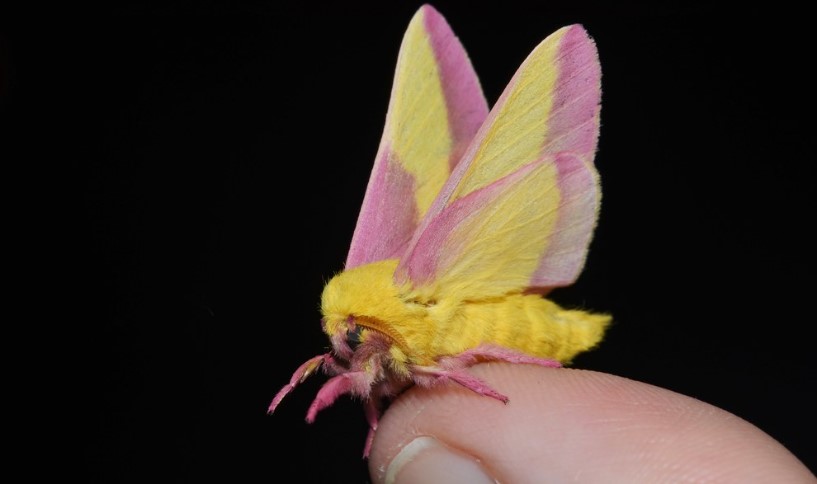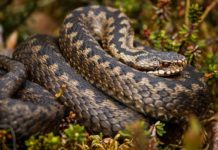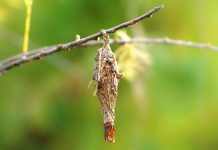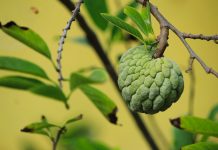Overview
The Rosy Maple Moth (Dryocampa rubicunda) is a species of moth native to North America. It is a brightly colored moth that is easily recognizable by its distinctive pink and yellow coloration. The adult moths are relatively small, with a wingspan of 1.5 to 2 inches, and they are active primarily at night. They are also known for their slow, undulating flight pattern.
The larvae of the Rosy Maple Moth feed on the leaves of maples and other hardwood trees. They are usually green or yellow in color and have a distinctive, caterpillar-like appearance. After several molts, the larvae spin a cocoon and pupate, emerging as adult moths several weeks later.
In addition to its distinctive appearance, the Rosy Maple Moth is also known for its popularity among insect collectors and enthusiasts. The moth’s bright coloration and unusual appearance have made it a popular subject for photography, and it is often used as an educational tool for teaching children about the diversity of life. Despite its popularity, the Rosy Maple Moth has not been considered a significant pest and its populations are considered stable.

Habitats
The Rosy Maple Moth is native to North America and is found primarily in the eastern United States, ranging from Maine to Florida and west to Texas. It inhabits a variety of habitats, including deciduous and mixed forests, woodlands, parks, and residential areas with mature trees.
The Rosy Maple Moth relies on its host tree, the maple, for both food and habitat. The larvae feed on the leaves of various species of maples, including the Red Maple, Silver Maple, and Sugar Maple. Adult moths feed on nectar from flowers, such as those of the wild cherry, hawthorn, and blueberry.
In order to conserve the Rosy Maple Moth, it is important to protect its habitat, including its host trees and other nectar sources. This can be done by preserving forests, planting native trees, and avoiding the use of pesticides that may harm moths and other beneficial insects. By protecting the Rosy Maple Moth and its habitat, we can help ensure the survival of this unique and colorful species for generations to come.
Eggs
The eggs of the Rosy Maple Moth are small, round, and yellow in color. They are usually laid on the underside of maple leaves in clusters of up to 50 eggs. The female moth typically lays her eggs in the late spring or early summer, and they hatch within a few days to a week. After hatching, the larvae emerge and begin feeding on the leaves of the maple tree. They grow rapidly, molting several times before pupating and emerging as adult moths several weeks later.
The larvae of the Rosy Maple Moth are usually green or yellow in color and have a distinctive, caterpillar-like appearance. Therefore, while the eggs and larvae of the Rosy Maple Moth do feed on the leaves of the maple tree, they are not considered significant pests and do not cause significant damage to the tree. In fact, the Rosy Maple Moth is considered a beneficial insect, as its larvae serve as a food source for many species of birds and other predators. By preserving the habitat of the Rosy Maple Moth and its host trees, we can help ensure the survival of this unique and colorful species.
Size
The Rosy Maple Moth is a relatively small species of moth, with a wingspan of approximately 1.5 to 2 inches (4-5 cm). The adult moths have a distinctive pink and yellow coloration, with the forewings being pink and the hindwings being yellow. The body of the moth is also yellow and covered in fine, white hair.
The larvae of the Rosy Maple Moth are usually green or yellow in color and have a distinctive, caterpillar-like appearance. They are approximately 1.5 inches (3.8 cm) long when fully grown and are covered in fine, white hair. The larvae are plump and have a distinctive hump-backed appearance, with a black head and a series of yellow and blue stripes running down their body. Despite their small size, the Rosy Maple Moth is easily recognizable due to its distinctive coloration and is a popular subject for photography and study.
Meaning
The meaning or symbolism associated with the Rosy Maple Moth is a matter of interpretation, as it can be viewed in different ways by different cultures and individuals. However, there are some common themes and interpretations that are associated with the Rosy Maple Moth.
For some, the Rosy Maple Moth represents renewal and transformation, as it transforms from an egg to a larva, then a pupa, and finally into an adult moth. The bright pink and yellow coloration of the adult moth symbolizes joy and happiness and may be seen as a reminder to embrace life’s beauty and appreciate the simple things.
In some Native American cultures, the Rosy Maple Moth is seen as a symbol of change and growth. The yellow color of the larvae and the adult moth is often associated with the sun and with light and may symbolize hope and positive energy. The moth’s close association with the maple tree, a tree that is known for its beauty and strength, adds additional symbolism and meaning to the Rosy Maple Moth.
Overall, the meaning and symbolism of the Rosy Maple Moth can vary greatly, depending on cultural and personal perspectives. However, its beauty and unique life cycle make it a popular subject for study and appreciation, and it remains an important and beloved species in the natural world.
Poisonous
As for whether the Rosy Maple Moth is poisonous, it is not considered to be poisonous to humans or to other animals. The larvae feed on the leaves of the maple tree, and while they may cause some minor damage to the leaves, they are not considered significant pests. The adult moths feed on nectar from flowers and do not pose a threat to humans or other animals.
Therefore this little caterpillar is not considered poisonous, it is still important to avoid handling it excessively, as the scales on its wings can be easily rubbed off, damaging the moth’s ability to fly and potentially reducing its lifespan. By preserving its habitat and avoiding unnecessary handling, we can help ensure the survival of this unique and beautiful species for future generations.

Life Spans
The lifespan of the Rosy Maple Moth is relatively short, lasting only a few weeks as an adult. The adult moths mate and lay their eggs shortly after emergence, and then die within a few days. The eggs hatch into larvae within a few days to a week, and the larvae feed on the leaves of the maple tree for several weeks before pupating and emerging as adult moths. The total lifespan of the Rosy Maple Moth, from egg to adult, is typically about 6 to 8 weeks. Read More – Bagworm Moth Caterpillar builds Log House like Cocoon
Other Facts:
-
Scientific name: Dryocampa rubicunda
-
Family: Saturniidae
-
Higher classification: Dryocampa
-
Order: Lepidoptera
-
Kingdom: Animalia
-
Phylum: Arthropoda
-
Rank: Species






